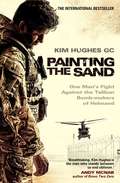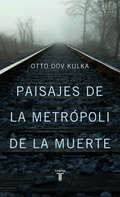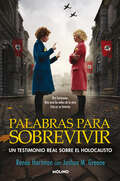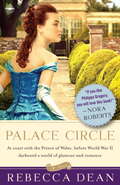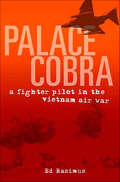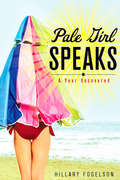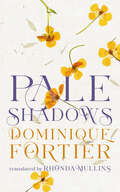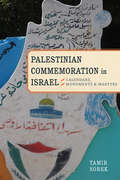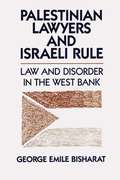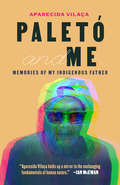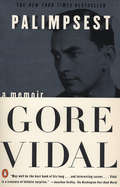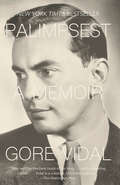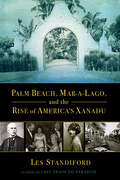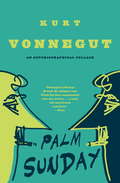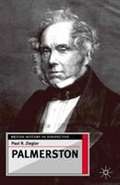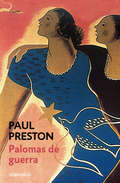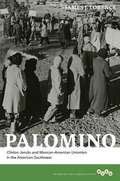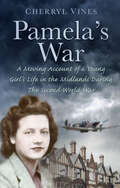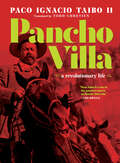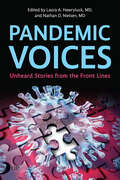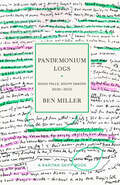- Table View
- List View
Painting the Sand
by Kim HughesKim Hughes is the most highly decorated bomb disposal operator serving in the British Army. He was awarded the George Cross in 2009 following a grueling six-month tour of duty in Afghanistan during which he defused 119 improvised explosive devices, survived numerous Taliban ambushes and endured a close encounter with the Secretary of State for Defence. The back drop to Painting the Sand will be the Afghan War, the conflict where the cold courage of the bomb disposal operator rose to national prominence. No other field of warfare offers the chance of a single individual to come so close to his enemy and fight out a battle of wits where losing can means death. This is one of the best memoirs that will come out of a ten-year struggle to defeat a hidden, and enduring, enemy.
Paisajes de la metrópoli de la muerte: Reflexiones sobre la memoria y la imaginación
by Otto Dov KulkaUn libro de memorias de extraordinaria fuerza literaria y emocional que explora las indelebles huellas de una infancia en Auschwitz. De niño, el prestigioso historiador Otto Dov Kulka fue enviado junto con su familia al gueto de Theresienstadt, y más tarde a Auschwitz. Tras sobrevivir al horror, ha pasado gran parte de su vida estudiando el nazismo y el Holocausto, pero siempre como una disciplina que exigía la mayor objetividad, dejando a un lado su propia historia personal. Sin embargo, durante ese tiempo los recuerdos de su infancia han permanecido alojados en su memoria, imágenes y pensamientos de los que ha sido incapaz de desprenderse. Hasta hoy. El extraordinario resultado son estas memorias profundamente conmovedoras, el testimonio poderoso y valiente de un hombre que ha querido entender su pasado y, con ello, nuestra historia. Reseñas:«Este es uno de los más extraordinarios testimoniossobre la barbarie que conozco. Los enormemente conmovedores recuerdos de los años de infancia de Dov Kulka en Auschwitz, entretejidos con sus reflexiones de esencia elegíaca y poética, transmiten vívidamente el horror de un campo de concentración, el trauma de la familia y los amigos, y la huella indeleble marcada en la memoria de un joven que se convirtió en un distinguido historiador del Holocausto. Una obra extraordinariamente importante que debe ser leída.»Ian Kershaw «Lo que hace que este libro no se parezca a ningún otro relato escrito de primera mano sobre los campos de concentración es la autenticidad de su visión de niño de once años... Kulka ha tenido con el resto de nosotros -y del mundo- la mayor de las generosidades al escribir este libro.»Simon Schama, The Financial Times «Sencillamente extraordinario... No se me ocurre cómo podría ser superado este libro.»Robert Eaglestone, Times Higher Education «A la vez deslumbrante y tenebroso... No se trata de otro relato más sino de algo más complicado: una especie de diálogo entre el niño que ya no es y el historiador en que se ha convertido.»Livres Hebdo «A menudo se dice que el testimonio de Levi es el propio de un químico: claro, frío, preciso, distante. De igual modo, la obra de Kulka es el producto de un historiador experto: irónico, penetrante, presente en el pasado, capaz de conectar lo particular con lo cósmico. Su memoria queda al servicio de la comprensión histórica profunda, transformada en evocativa prosa... Este libro es un esfuerzo para tender un puente entre dos modos de conocimiento: erudición histórica y análisis de un lado, memoria reflexiva e imaginación del otro.»Thomas Laqueur, The Guardian «Una seria, poética y desoladora narración del Holocausto que no es tanto un repaso del Auschwitz del pasado, como del Auschwitz del mundo interior de Kulka. Es su propia ciudad interiorizada, con su propio y perdurable horror.»Arifa Akbar, The Independent «Bello y deslumbrante... Este es un gran libro. Léalo. Y siéntase agradecido: esta obra es, en todos los sentidos posibles, un milagro.»Bryan Appleyard, Sunday Times Culture «Un libro sorprendente e inclasificable... Excepcional.»Nicolas Weill, Le Monde «Magistral... Un texto estremecedor y sarcástico cuya lectura no deja indemne.»Sylvie Arsever, Le Temps «Nada de lo que he leído se acerca a este profundo examen de lo que significa el Holocausto.»Linda Grant, New Statesman «Un libro asombroso entre los recuerdos y la imaginación.»Emmanuel Hecht, L'Express
Palabras para sobrevivir: Un testimonio real sobre el Holocausto
by Joshua M. Greene Renee HartmanUn libro perfecto para que los niños conozcan la historia del Holocausto: una memoria que habla sobre la importancia de la sororidad, el amor y el recuerdo del pasado. En aquel momento tenía diez años, y mi hermana, ocho. Era mi responsabilidad avisar a todos cuando venían los soldados, porque tanto mi hermana como mis padres eran sordos. Yo era los oídos de mi familia.Renee y Herta vivieron lo inimaginable juntas, como hermanas. Esta es su historia real. Como muchos judíos checoslovacos en los años 40, Renee y su familia estaban en peligro cuando el Holocausto llegó a su puerta. La única persona oyente de su familia, Renee, era la encargada de comunicarse con el mundo exterior. Hablando con lenguaje de signos y apoyándose entre ellas, Renee y Herta lucharon para sobrevivir la época más oscura de su vida.Este testimonio de una de las pocas supervivientes del Holocausto es una prueba del poder de la sororidad y el amor, y un recordatorio de lo importante que es no olvidar el pasado. Una historia real, impactante y conmovedora a partes iguales. Adaptado para niños y niñas a partir de 9 años.
Palace Circle
by Rebecca Deanâ Palace Circle is a gem, filled with dashing lords, gutsy ladies, family secrets and royal intrigue. â Barbara DelinskyAmerican Heiress Delia Chandler leaves Virginia to marry Viscount Ivor Conisborough, completely unprepared for her new place within the royal circle. Soon she is holding dinner parties for Winston Churchill and Wallis Simpson and attending glittering balls with Prince Edward. But beneath the dazzling façade, Delia quickly discovers a world steeped in scandal. It seems everyone has a secret, including her husband. When Ivor is sent to Cairo and appointed advisor to King Fuad, Delia must follow with her two daughters. Like their mother, Petra and Davina are fiery beauties who long to escape the elegant and palatial villas of Garden City for the exotic, wild beating heart of Cairo. But their desires will lead them into dangerous territory, shattering their world as they know it, forever. Drenched in glamour, secrets and scandal, Palace Circle is an irresistible combination of real historical events and masterful storytelling.
Palace Cobra: A Fighter Pilot in the Vietnam Air War
by Ed RasimusPalace Cobra picks up where Ed Rasimus's critically acclaimed When Thunder Rolled left off. Now he's flying the F-4 Phantom and the attitude is still there.In the waning days of the Vietnam War, Rasimus and his fellow pilots were determined that they were not going be the last to die in a conflict their country had abandoned. They were young fighter pilots fresh from training and experienced aviators who came back to the war again and again, not for patriotism, but for the adrenaline rush of combat. From the bathhouses and barrooms to the prison camps of North Vietnam, this is a gripping combat memoir by a veteran fighter pilot who experienced it all.The wry cynicism of a combat aviator will give readers insights into the Vietnam experience that haven't been available before, and the heart-stopping action will keep readers turning the pages all night.
Palacios, un caballero socialista
by Daniel SorínUn rumor se esparce en la Buenos Aires de 1965: dice que Alfredo Palacios, el ilustre socialista, ateo natural, antes de morir habría solicitado el auxilio de un sacerdote para que le diera la extremaunción. La sorpresa mayúscula cae en manos de un detective, Washington Cruz. Lo contrata un sujeto elusivo, una pantalla sobria para intereses funestos que desean corroborar ese dato y hacer de él un tesoro. Y quizás también una provechosa venganza. Pero, como suele suceder, la investigación se abre a caminos inesperados, y en vez de recomponer su último momento, sus últimos días, lo que Cruz expurga es la vida íntegra de Palacios: la infancia pobre, el encuentro con Quinquela Martín, su amistad con Jorge Newbery, su amor por las mujeres, su apego extremo a la caballerosidad y los duelos a pistola para limpiar el honor o una afrenta singular. Y, por supuesto, la militancia en el socialismo, la política, esa línea de agua que lo acompaña desde su adolescencia hasta el final. Son seis décadas que tienen su comienzo triunfal en 1904, cuando es elegido como el primer diputado socialista en América, y que atraviesan la Argentina del Centenario, la de Yrigoyen, la década infame, el peronismo, el antiperonismo, y la caída de Perón. Al término de la novela Washington Cruz sabe si su investigado ha pedido o no la protección de la fe; sin embargo, para entonces el mayor asombro no pasa por la muerte sino por la vida novelesca de ese hombre que ha desfilado ante sus ojos. A partir de un misterio en clave de policial, Daniel Sorín escribió, soberbia, una ficción política, y a la vez una indagación, de un personaje descollante de la Argentina del siglo XX. Con una prosa encendida, que contiene los ecos agudos de lo popular y la sobriedad nunca árida de los porteños de antaño, se opone al atropello de la historia que todo lo distorsiona y dibuja un casillero limpio, independiente, intacto de miserias y mediocridades: allí está su Alfredo Palacios.
Pale Girl Speaks: A Year Uncovered
by Hillary FogelsonHillary Fogelson led a charmed life: as the young wife of a successful Hollywood executive, her only major concerns were her acting auditions, interior decorating, and unexpected visits from her high-maintenance parents. Then, one day, her doctor told her she had malignant melanoma-a cancer that leads to more deaths for women between the age of 25 and 30 than any other-and her life was forever changed. Pale Girl Speaksis the darkly funny story of Fogelson’s neuroses and struggles after her diagnosis with melanoma. In her witty, wisecracking narrative, Fogelson recounts how her battle with cancer brings up other issues in her life that she’s been ignoring, especially her anxieties about her relationship with her husband, her friends, and her parents. The apprehension she feels soon manifests itself in more concrete ways-panic attacks, heavy reliance on alcohol, and a compulsive need to constantly check in with her doctor-but when her father discovers that he has melanoma as well, Fogelson has to learn to lead by example and let go of her fear. A story that will appeal to anyone who has faced adversity and lived to tell jokes about it,Pale Girl Speaksis about one woman who experienced the worst possible fallout of being fair-skinned-and survived with her sense of humor intact.
Pale Shadows
by Dominique FortierDickinson after her death: a novel of the trio of women who brought Emily Dickinson’s poems out of the shadows When she died, Emily Dickinson left behind hundreds of texts scribbled on scraps of paper. She also left behind three formidable women: her steadfast sister, Lavinia; her brother’s ambitious mistress, Mabel Loomis Todd; and his grief-stricken wife, Susan Gilbert Dickinson. With no clear instructions from Emily, these three women would, through mourning and strife, make from those scraps of paper a book that would change American literature. From the author of Paper Houses, this is the improbable, almost miraculous, story of the birth of a book years after the death of its author. In these sensitive and luminous pages, Dominique Fortier explores, through Dickinson’s poetry, the mysterious power that books have over our lives, and the fragile and necessary character of literature.
Palestinian Commemoration in Israel: Calendars, Monuments, and Martyrs
by Tamir SorekCollective memory transforms historical events into political myths. In this book, Tamir Sorek considers the development of collective memory and national commemoration among the Palestinian citizens of Israel. He charts the popular politicization of four key events--the Nakba, the 1956 Kafr Qasim Massacre, the 1976 Land Day, and the October 2000 killing of twelve Palestinian citizens in Israel--and investigates a range of commemorative sites, including memorial rallies, monuments, poetry, the education system, political summer camps, and individual historical remembrance. These sites have become battlefields between diverse social forces and actors--including Arab political parties, the Israeli government and security services, local authorities, grassroots organizations, journalists, and artists--over representations of the past. Palestinian commemorations are uniquely tied to Palestinian encounters with the Israeli state apparatus, with Jewish Israeli citizens of Israel, and by their position as Israeli citizens themselves. Reflecting longstanding tensions between Palestinian citizens and the Israeli state, as well as growing pressures across Palestinian societies within and beyond Israel, these moments of commemoration distinguish Palestinian citizens not only from Jewish citizens, but from Palestinians elsewhere. Ultimately, Sorek shows that Palestinian citizens have developed commemorations and a collective memory that offers both moments of protest and points of dialogue, that is both cautious and circuitous.
Palestinian Lawyers and Israeli Rule: Law and Disorder in the West Bank
by George Emile BisharatAs frequent intermediaries between Israeli military authorities and Palestinian citizens, Palestinian lawyers stand close to the fault line dividing Israeli and Palestinian societies. The conflicts and tensions they experience in their profession mirror the larger conflicts between the two societies. Thus, as George Bisharat reveals in Palestinian Lawyers and Israeli Rule, a careful study of the work and lives of Palestinian lawyers ultimately helps to illuminate the causes of the intifada, or uprising, that began in December 1987. The study revolves around the central question of why the Palestinian legal profession declined during twenty years of Israeli occupation when, in other Third World countries, the legal profession has often reached its peak during a period of Western colonization. Bisharat answers this question with a wide-ranging inquiry into the historical origins of the legal profession and court system in Palestine, the tenuous grounding of these institutions in Palestinian society and culture, and the structure, style, and policies of the late-twentieth-century Israeli military government in the West Bank. For general readers interested in the Palestinian-Israeli conflict, as well as specialists in such fields as legal anthropology, sociology of the professions, Third World law and development, and Middle Eastern studies, Palestinian Lawyers and Israeli Rule will be required reading. As frequent intermediaries between Israeli military authorities and Palestinian citizens, Palestinian lawyers stand close to the fault line dividing Israeli and Palestinian societies. The conflicts and tensions they experience in their profession mirror the larger conflicts between the two societies. Thus, as George Bisharat reveals in Palestinian Lawyers and Israeli Rule, a careful study of the work and lives of Palestinian lawyers ultimately helps to illuminate the causes of the intifada, or uprising, that began in December 1987. The study revolves around the central question of why the Palestinian legal profession declined during twenty years of Israeli occupation when, in other Third World countries, the legal profession has often reached its peak during a period of Western colonization. Bisharat answers this question with a wide-ranging inquiry into the historical origins of the legal profession and court system in Palestine, the tenuous grounding of these institutions in Palestinian society and culture, and the structure, style, and policies of the late-twentieth-century Israeli military government in the West Bank. For general readers interested in the Palestinian-Israeli conflict, as well as specialists in such fields as legal anthropology, sociology of the professions, Third World law and development, and Middle Eastern studies, Palestinian Lawyers and Israeli Rule will be required reading.
Paletó and Me: Memories of My Indigenous Father
by Aparecida VilaçaWinner of the prestigious Casa de las Américas Prize, this work spins a heartfelt story of an improbable relationship between an anthropologist and her charismatic Indigenous father. When Aparecida Vilaça first traveled down the remote Negro River in Amazonia, she expected to come back with notebooks and tapes full of observations about the Indigenous Wari' people—but not with a new father. In Paletó and Me, Vilaça shares her life with her adoptive Wari' family, and the profound personal transformations involved in becoming kin. Paletó—unfailingly charming, always prepared with a joke—shines with life in Vilaça's account of their unusual father-daughter relationship. Paletó was many things: he was a survivor, who lived through the arrival of violent invaders and diseases. He was a leader, who taught through laughter and care, spoke softly, yet was always ready to jump into the unknown. He could shift seamlessly between the roles of the observer and the observed, and in his visits to Rio de Janeiro, deconstructs urban social conventions with ease and wit. Begun the day after Paletó's death at the age of 85, Paletó and Me is a celebration of life, weaving together the author's own memories of learning the lifeways of Indigenous Amazonia with her father's testimony to Wari' persistence in the face of colonization. Speaking from the heart as both anthropologist and daughter, Vilaça offers an intimate look at Indigenous lives in Brazil over nearly a century.
Palimpsest: A Memoir
by Gore VidalPublished to celebrate his 70th birthday, the memoirs of the American writer, from his childhood as the grandson of a blind southern senator, through to the establishment of his literary career in 1964.
Palimpsest: A Memoir (Primera Persona Ser.)
by Gore VidalThis explosively entertaining memoir abounds in gossip, satire, historical apercus, and trenchant observations. Vidal's compelling narrative weaves back and forth in time, providing a whole view of the author's celebrated life, from his birth in 1925 to today, and features a cast of memorable characters—including the Kennedy family, Marlon Brando, Anais Nin, and Eleanor Roosevelt.
Palimpsest: A Memoir (Vintage International)
by Gore VidalVidal on Vidal—a great and supremely entertaining writer on a great and endlessly fascinating subject.A New York Times best American memoir&“In the hands of Gore Vidal, a pen is a sword. And he points it at the high and mighty who have crossed his path.&” —Los Angeles Times Palimpsest is Gore Vidal's account of the first thirty-nine years of his life as a novelist, dramatist, critic, political activist and candidate, screenwriter, television commentator, controversialist, and a man who knew pretty much everybody worth knowing (from Amelia Earhart to Eleanor Roosevelt, the Duke and the Duchess of Windsor, Jack Kennedy, Jaqueline Kennedy, Jack Kerouac, Truman Capote, Andre Gide, and Tennessee Williams, and on and on). Here, recalled with the charm and razor wit of one of the great raconteurs of our time, are his birth into a DC political clan; his school days; his service in World War II; his emergence as a literary wunderkind in New York; his time in Hollywood, London, Paris and Rome; his campaign for Congress (outpolling JFK in his district); and his legendary feuds with, among many others, Truman Capote and William F. Buckley. At the emotional heart of this book is his evocation of his first and greatest love, boyhood friend Jimmy Trimble, killed in battle on Iwo Jima.
Palm Beach, Mar-a-Lago, and the Rise of America's Xanadu
by Les StandifordFrom the first Gilded Age to the second, a “charming, zippy history . . . a rollicking, informative lesson in real estate, American history, and current events.” —Town & CountryLooking at the island of Palm Beach today, with its unmatched mansions, tony shops, and pristine beaches, one is hard pressed to visualize the dense tangle of Palmetto brush and mangroves that it was when visionary entrepreneur and railroad tycoon Henry Flagler first arrived there in April 1893. Trusting his remarkable instincts, he built the Royal Poinciana Hotel within a year, and two years later, what was to become the legendary Breakers—instantly establishing the island as the preferred destination for those who could afford it. Over the next 125 years, Palm Beach has become synonymous with exclusivity—especially its most famous residence, Mar-a-Lago. As Les Standiford relates, the high walls of Mar-a-Lago and other manses like it were seemingly designed to contain scandal within as much as keep intruders out.This book tells the history of this fabled landscape intertwined with the colorful lives of its famous and infamous protagonists, from Flagler’s two wives to architect Addison Mizner, who created Palm Beach’s “Mediterranean look” to heiress Marjorie Merriweather Post and her husband E. F. Hutton, the original residents of Mar-a-Lago. With authoritative detail, Standiford recounts how Marjorie ruled Palm Beach society until her death in 1973, and how the fate of her mansion threatened to tear apart the very fabric of the town until Donald Trump acquired it in 1985.“Edifying, energetic, and captivating.” —Florida Weekly
Palm Sunday
by Kurt Vonnegut Jr.In this self-portrait by an American genius, Kurt Vonnegut writes with beguiling wit and poignant wisdom about his favorite comedians, country music, a dead friend, a dead marriage, and various cockamamie aspects of his all-too-human journey through life. This is a work that resonates with Vonnegut's singular voice: the magic sound of a born storyteller mesmerizing us with truth.
Palmerino
by Melissa PritchardO, The Oprah Magazine "Title to Pick Up Now"Welcome to Palmerino, the British enclave in rural Italy where Violet Paget, known to the world by her pen name and male persona, Vernon Lee, held court. In imagining the real life of this brilliant, lesbian polymath known for her chilling supernatural stories, Melissa Pritchard creates a multilayered tale in which the dead writer inhabits the heart and mind of her lonely, modern-day biographer.Positing the art of biography as an act of resurrection and possession, this novel brings to life a vividly detailed, subtly erotic tale about secret loves and the fascinating artists and intellectuals-Oscar Wilde, John Singer Sargent, Henry James, Robert Browning, Bernard Berenson-who challenged and inspired each other during an age of repression.Melissa Pritchard is the author of eight books of fiction, including The Odditorium, a San Francisco Chronicle Best Book of the Year. Among other honors, her books have received the Flannery O'Connor, Janet Heidinger Kafka, and Carl Sandburg awards, and two of her short fiction collections were New York Times Notable Book and Editor's Choice selections.
Palmerston (British History In Perspective Ser.)
by Paul R. ZieglerIn serving more than fifty years in public life, Palmerston placed his stamp upon nineteenth-century Britain. Born and bred an eighteenth-century aristocrat, he initially seemed out of place in a world stirred by the twin forces of the French and Industrial Revolutions, and more suited to the dandified life of the beau monde. As a conservative politician, he appeared ill fit for an age of reform, and as Foreign Secretary his gunboat diplomacy courted war and revolution at a time when European diplomats were seeking peace and stability. However, as Paul R. Ziegler's compelling biography shows, the 3rd Viscount Palmerston was a man of contradictions. Despite his aristocratic roots and playboy image, Palmerston was a tireless public servant and a meticulous planner, who identified himself with the people and became their natural spokesperson - a role which culminated in his eventual election as Prime Minister. Whilst fearing the advent of democracy, he was willing to experiment with reform; and although seemingly averse to the onrush of modernity, he nevertheless seized the initiative both at home and abroad in leading his nation into the future. Taking into account recent scholarship and revisionist approaches, Ziegler authoritatively reviews the life of this well-known political figure and reassesses his contribution to the nineteenth century - demonstrating that, in facing new challenges, Palmerston adjusted himself to the times and helped to usher Britain into the modern age.
Palomas de guerra: Cinco Mujeres Marcadas Por El Enfrentamiento Bélico (Así Fue Ser. #Vol. 48)
by Paul PrestonMercedes Sanz-Bachiller, Nan Green, Priscilla Scott-Ellis, Margarita Nelken y Carmen Polo son los cinco personajes de este libro riguroso, documentado y conmovedor en el que Paul Preston aúna el trabajo de investigación con las historias personales y emotivas de cinco mujeres únicas y relativamente poco conocidas de la historia de España. Palomas de guerra es la continuación de Las tres Españas del 36, Primer Premio Así Fue, aunque en esta ocasión el autor ha preferido concentrarse en una serie de personajes femeninos -dos inglesas y dos españolas, dos de derechas y dos de izquierdas, y un quinto personaje, Carmen Polo, esposa de Franco, que no tiene nada que ver con las cuatro mujeres anteriores-, cuyo nexo común es que sus vidas estuvieron marcadas, de una manera u otra, por la tragedia de la Guerra Civil. De diferentes nacionalidades, orígenes sociales e ideologías, cuatro de ellas eran valientes, independientes y compasivas, algunas enviudaron, otras perdieron hijos y todas quedaron profundamente traumatizadas por la contienda. Ninguno de esos sufrimientos afectó a la quinta, cuya vida también quedó drásticamente marcada por el conflicto bélico, pero de una manera muy diferente.
Palomino: Clinton Jencks and Mexican-American Unionism in the American Southwest
by James J. LorenceThe first comprehensive biography of progressive labor organizer, peace worker, and economist Clinton Jencks (1918-2005), this book explores the life of one of the most important political and social activists to appear in the Southwestern United States in the twentieth century. A key figure in the radical International Union of Mine, Mill, and Smelter Workers (IUMMSW) Local 890 in Grant County, New Mexico, Jencks was involved in organizing not only the mine workers but also their wives in the 1951 strike against the Empire Zinc Company. He was active in the production of the 1954 landmark labor film dramatizing the Empire Zinc strike, Salt of the Earth, which was heavily suppressed during the McCarthy era and led to Jencks's persecution by the federal government. Labor historian James J. Lorence examines the interaction between Jencks's personal experience and the broader forces that marked the world and society in which he worked and lived. Following the work of Jencks and his equally progressive wife, Virginia Derr Jencks, Lorence illuminates the roots and character of Southwestern unionism, the role of radicalism in the Mexican-American civil rights movement, the rise of working-class feminism within Local 890 and the Grant County Mexican American community, and the development of Mexican-American identity in the Southwest. Chronicling Jencks's five-year-long legal battle against charges of perjury, this biography also illustrates how civil liberties and American labor were constrained by the specter of anticommunism during the Cold War. Drawing from extensive research as well as interviews and correspondence, this volume highlights Clinton Jencks's dramatic influence on the history of labor culture in the Southwest through a lifetime devoted to progress and change for the social good.
Pamela's War: A Moving Account of a Young Girl's Life in the Midlands During the Second World War
by Cherryl VinesIt is the third of September 1939. It is just after half past eleven in the morning. I am fifteen years and sixteen days old. The radiogram at my home, the Woodman Hotel in Clent, has just been switched off, the silence resonates around the room, and a deathly hush has fallen. The Prime Minister, Neville Chamberlain, has declared that, despite the best efforts of the politicians of the day to secure ‘peace in our time’, the inevitable has befallen us; despite pledges to the contrary, Germany has invaded Poland, Hitler has ignored requests to back down and so, therefore, ‘Britain is now at war with Germany’. Minutes after the broadcast ends, my Father, Sidney Wheeler, goes quietly up to his room where he methodically loads three bullets into his First World War revolver. This is the true story of a fifteen-year-old girl’s experience of the Second World War, based around her parent’s hotel in a sleepy Worcestershire village. As war is declared, her father prepares three bullets for the invasion. He will shoot the family and himself when the Germans come. In their village, local Germans are imprisoned (guilty or not). The blackout is immediate and has tragic consequences. There is a court case over an alleged poker game. An abortion nearly results in tragedy. Handsome young airmen fly low over the hotel. Pamela has a premonition of death. The business fails. An air raid very nearly kills them all. She is called up first to factory work and then to the Land Army. She marries by special licence. As the war comes to an end she is living at home with her parents and a small baby, at which point she is just twenty-one years of age. Amusing and entertaining, surprising and often moving, Pamela's account vividly captures one family’s life on the home front in Worcestershire.
Pancho Villa: A Revolutionary Life
by Paco Ignacio Taibo IIA wild ride and revealing portrait of the controversial Pancho Villa, one of Mexico&’s most beloved (or loathed) heroes, that finally establishes the importance of his role in the triumph of the Mexican Revolution, by renowned writer Paco Ignacio Taibo II.The last biography of Pancho Villa was published 25 years ago, and this new edition has been translated into English for the first time. This biography marks a kind of reinvention of the legendary Mexican figure of Pancho Villa. It is a masterful reevaluation and heavily researched account of his life. This book makes a new claim, finally giving Pancho Villa his due as the decisive figure in the success of Mexican Revolution. Here he is less the colorful bandito and more the incorruptible conscience that not only won key battles, but also maintained the revolutionary vision and led the way in terms of class consciousness.Pancho Villa is a rollicking, sometimes hilariously comical, sometimes extremely violent, and always very personal portrait of the controversial Mexican historical figure Pancho Villa. Beloved crime writer Paco Ignacio Taibo II (a.k.a. PIT)—the prolific historian, biographer of Che Guevara and the founder of Mexican &“neopolicial&” fiction—brings his tremendous storytelling skills to an account of one of the Mexico&’s greatest legendary characters.With his vibrant narrative style, Taibo describes the adventures of Pancho Villa with incredible stories, the stuff of history and tragedy, backed up by tremendous research. Throughout, Taibo unveils secrets about the life of one of Mexico's most courageous and charismatic leaders. Includes period photographs that indelibly capture the rocky transition from the wild and agrarian past towards modern statehood.
Pandemic Voices: Unheard Stories from the Front Lines
by Laura A. Hawryluck Nathan D. NielsenPandemic Voices sheds light on previously unheard or overlooked international perspectives of patients and health care and community services workers through unprecedented access to some of the most challenging moments of the COVID-19 pandemic: the innovations, the stories of lives saved, those of lives lost, and the prices paid. Divided into seven thematic sections, the collection chronicles the experiences from the front lines of the pandemic. It highlights the disruptions faced by medical systems and the innovative adaptations that emerged to simply keep them functioning, as well as the pandemic impacts from locations overlooked by global media. The book delves into the profound effects on health care workers and reveals insights into strain on health care systems. It amplifies the voices of individuals who faced unique struggles during the pandemic, such as caregivers for children with special needs or individuals battling addiction, in times when resources were basically non-existent in a chaotic landscape. The collection concludes with a reflection on how history will judge our pandemic-era actions, alongside the hard lessons learned on truth, science, and advocacy throughout these challenging years. In sharing the heartbreaks, the triumphs, and the scars that left none of us untouched, Pandemic Voices assesses what we have been through – what went well, what did not – in order to learn and, in time, hopefully to heal.
Pandemonium Logs: Sioux Falls, South Dakota, 2020–2022 (Raritan Skiff Books)
by Ben MillerIn 2015, Ben Miller and the poet Anne Pierson Wiese moved from New York City to Sioux Falls, South Dakota, to explore their midwestern roots and to focus on their writing careers. Working a day job in a hospital, Miller had a front-row seat to the COVID-19 pandemic as it moved from the coasts to the urban Midwest. Pandemonium Logs casts an unflinching eye on the state of the worker in the US health-care system during a global pandemic, giving voice to the doctors, nurses, support staff, patients, and families caught in the complex swirl of daily dilemmas and crucial choices. In unsparing yet sympathetic prose, Ben Miller creates an intimate portrait of the impact of COVID on the diverse people of South Dakota. Through a wide range of characters—from understandably confused patients to quietly competent nurses—he explores the human complexities of the crisis: a doctor based in Mumbai who treats critically ill patients in the Dakotas via a tenuous hodgepodge of telehealth apparatus, a Hydra of six workplace trainers who together cannot train one employee to do one job, a vice president of corporate hospitality who lives to rip down safety signs as fast as nurses post them, a ninety-year-old hospital volunteer who pushes wheelchairs containing patients half his age. In Pandemonium Logs, Miller provides precise and moving observations of ordinary people doing extraordinary things.
Pandit Atombapu Sharma
by E. Nilakanta SinghFrom the Introduction: Pandit Atombapu Sharma, Vidyaratna, Gaveshana Shiromani, a great scholar of Sanskrit, of Brahmanical Philosophy, a pious Vaishnava, versed in astronomy and astrology, a journalist and social reformer, was indeed a renaissance man. He was a veritable rishi of intellect, feeling and vision. Like draws the like and the great Indian scholar and linguist, Dr. S. K. Chatterjee understood him and paid his tribute to the great scholar thus: "His work in the religio-cultural domain even in the present age would easily recall the services like those rendered e.g. by Agastya in South India".
